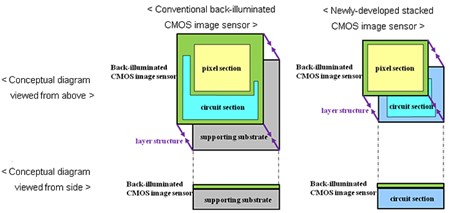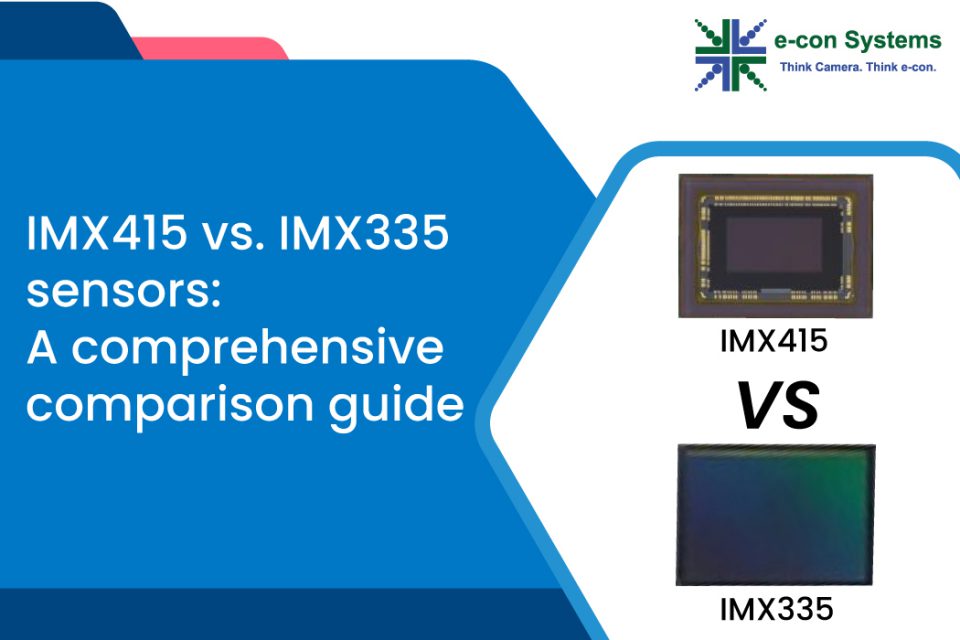In today’s embedded world, image sensors are vital in determining overall camera performance. Plus, sensor technologies are constantly evolving in a bid to revolutionize the industry. As a result, there is always a demand for image sensors that register the packed combination of compactness, high frame rate, low light performance, fast readout times, wide dynamic range, and high resolution. For instance, 1/2.8″ sensors are in high demand in smart surveillance, industrial, and factory automation (FA) markets since they are compact and fit the form factor of a vast majority of embedded systems.
In this article, we will discuss two 1/2.8″ CMOS image sensors – IMX415 and IMX335 – developed by SONY Semiconductor Solution (SSS) Corporation and how each of these sensors compares when pitted against each other.
What are IMX415 & IMX335 sensors?
Before we compare the IMX415 and IMX335 sensors, let us understand what they are.
IMX415 is a 1/2.8-type 4K-resolution stacked CMOS image sensor developed by SONY. This sensor has a 6.43mm diagonal providing a resolution of 8.4 MP with 3864(H) × 2192(V) effective number of pixels and a high-speed frame rate of 90 fps at 10-bit. It is also considered the smallest sensor among 4K-resolution CMOS image sensors as it miniaturizes the pixel size to 1.45 square μm.
On the other hand, IMX335 is a 1/2.8-type HDR backside illuminated CMOS image sensor developed by SONY. This sensor is sized 6.52mm diagonally – providing a resolution of 5 MP with a 2592 (H) x 1944 (V) number of pixels and a high-speed frame rate of 60 fps at 10-bit.
What are the key specifications of IMX415 & IMX335 sensors?
Let us now dive deep into the technical details of IMX415 and IMX335 sensors.
| Model name | IMX335 | IMX415 | |
| Number of effective pixels | 2592 (H) x 1944 (V) | 3864(H) × 2192(V) | |
| Resolution | 5.14 MP | 8.4 MP | |
| Image size | Diagonal: 6.52mm (type 1/2.8) | Diagonal: 6.43mm (type 1/2.8) | |
| Unit cell size | 2μm (H) × 2μm (V) | 1.45μm (H) × 1.45μm (V) | |
| Frame rate | 10bit/12bit 60fps | 10bit 90fps, 12bit 60fps | |
| Sensitivity (F5.6) | 2200 digits | 2048 digits | |
| Voltage | Analog | 2.9V | 2.9V |
| Digital | 1.2V | 1.1V | |
| Interface | 1.8V | 1.8V | |
| Module Interface | MIPI CSI-2 (2/4 lane) | MIPI D-PHY 2/4 lanes | |
| Chromatics | Color / Mono | Color / Mono | |
| Shutter Type | Electronic Rolling Shutter | Electronic Rolling Shutter | |
| Sensor Technology | CMOS | CMOS | |
| Focus Type | Fixed Focus, Auto focus | Fixed Focus, Auto focus | |
| HDR Function | Digital overlap (DOL) HDR | DOL HDR | |
| Package | 88 pin CSP BGA | 114 pin LGA | |
A deep look into the architecture of IMX415 & IMX335 sensors
IMX415 and IMX335 sensors are developed with the STARVIS™ technology. This technology applies a backside-illuminated (BSI) pixel structure, which can collect more light onto the photodiodes to reach high sensitivity and achieve high quality in visible and near-infrared light regions. The STARVIS™ technology offers an exceptional low light performance to embedded applications like security, surveillance, and industrial automation. It is extended by Prior Low Noise Circuit (PLNC), HDR functions, and the combination of DOL, binning mode and window cropping mode features.
SONY introduced the Stacked CMOS structure to increase the focus speed, accuracy, and subject recognition, which exceeds the BSI CMOS sensor’s performance.
As already discussed, IMX415 is a stacked CMOS image sensor that deals with challenging light conditions. Let us look at the architectural differences between BSI CMOS and Stacked CMOS sensors.

Figure 1: Architectural Differences between BSI CMOS and Stacked CMOS Sensors (Source: SONY)
A stacked CMOS sensor is the recent-generation BSI CMOS image sensor that layers the pixel section with back-illuminated structures over the chips containing signal processing circuits. In this stacked structure, the pixel section and circuit section are formed as independent chips, enabling higher image quality, faster signal processing and lower power consumption.
IMX415 vs. IMX335: A detailed and precise comparison
Let us look at the similarities and differences between IMX415 and IMX335 sensors along the following parameters:
Compact Chip Size
IMX415 sensor employs SONY’s proprietary stacked image sensor technology to miniaturize the pixel size to 1.45 square μm, which is smaller among 4K resolution 1/2.8-type sensors. As discussed, this technology fabricates the pixel section on the logic circuit section resulting in a smaller chip size.
On the other hand, the unit cell size of the IMX335 sensor is 2μm (H) × 2μm (V) with a diagonal of 6.52mm (1/2.8″), which is also a compact sensor suitable for applications that require medium resolution.
Sensitivity
Generally, if the size of the CMOS image sensor is smaller, then the light-collecting surface area of the sensor tends to be smaller. As a result, light sensitivity will be lower. At the same time, IMX415 and IMX335 sensors deliver high sensitivity by reversing the silicon substrate with the concept of BSI CMOS and Stacked CMOS. In this case, the light comes in from the back of the chip, and thus the light-collecting surface area of the pixel section can be expanded.
When we compare these sensors, the light sensitivity of the IMX415 sensor is higher than the IMX335 sensor because the former leverages the SONY-exclusive high sensitivity and low noise technology.
Resolution
The exact object detail in a scene can only be viewed from superior-quality images. As the IMX415 sensor adopts stacked CMOS image sensor technology, the pixel section in the chip is specialized with higher image quality even though its size is small. Also, this sensor is built with large-scale signal processing circuits, which is required for higher image quality and better functionality compared to the IMX335 sensor. Furthermore, multiple HDR filters in the IMX415 sensor further increase the image quality.
Low-Light Performance
The IMX415 sensor combines the STARVIS™ technology with the new Prior Low Noise Circuit (PLNC) technology for excellent visibility in low-light applications. This enables better SNR (Signal to Noise Ratio). On the other hand, IMX335 is also used as a compact sensor for low-light applications like smart traffic, industrial automation, parking lot management, etc.
In short, IMX415 is better when it comes to low-light performance. However, IMX335 can be used in those applications where low light performance of very high standards is not required.
Continue reading the article by providing your company email ID
We respect your privacy. Your email will only be used for content access validation.

Prabu is the Chief Technology Officer and Head of Camera Products at e-con Systems, and comes with a rich experience of more than 15 years in the embedded vision space. He brings to the table a deep knowledge in USB cameras, embedded vision cameras, vision algorithms and FPGAs. He has built 50+ camera solutions spanning various domains such as medical, industrial, agriculture, retail, biometrics, and more. He also comes with expertise in device driver development and BSP development. Currently, Prabu’s focus is to build smart camera solutions that power new age AI based applications.




